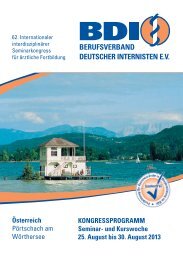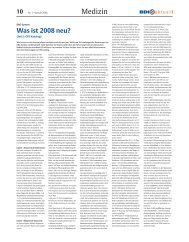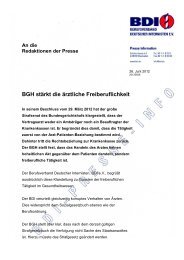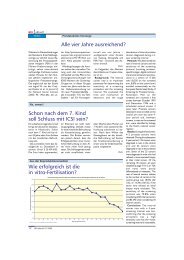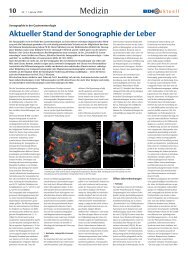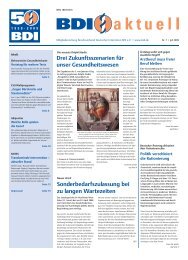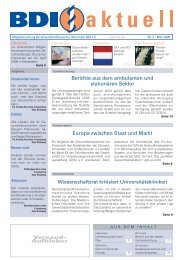Patienten taxieren und Gewinn optimieren? - beim BDI
Patienten taxieren und Gewinn optimieren? - beim BDI
Patienten taxieren und Gewinn optimieren? - beim BDI
Sie wollen auch ein ePaper? Erhöhen Sie die Reichweite Ihrer Titel.
YUMPU macht aus Druck-PDFs automatisch weboptimierte ePaper, die Google liebt.
<strong>BDI</strong> aktuell<br />
Medizin Neues zur Nierenersatztherapie<br />
Backgro<strong>und</strong>: The effects<br />
of the dose of dialysis and the<br />
level of flux of the dialyzer<br />
membrane on mortality and<br />
morbidity among patients<br />
<strong>und</strong>ergoing maintenance<br />
hemodialysis are uncertain.<br />
Methods: We <strong>und</strong>ertook<br />
a randomized clinical trial in<br />
1.846 patients <strong>und</strong>ergoing<br />
thrice-weekly dialysis, using a<br />
two-by-two factorial design to<br />
assign patients randomly to a<br />
standard or high dose of dialysis<br />
and to a low-flux of high-flux<br />
dialyzer.<br />
Results: In the standarddose<br />
group, the mean (±SD)<br />
Medizin Neuer Hit<br />
Ein neuer Hit aus dem New<br />
England Journal of Medicine<br />
(NEJM) sorgt für ein zwiespältiges<br />
Echo <strong>beim</strong> Betrachter. Nun<br />
sollen aus 70 Brustkrebspatienten-Genen<br />
eine „Good“- <strong>und</strong><br />
eine „Poor“-Signature für die<br />
Wahrscheinlichkeit eines Metastasen-freien<br />
Überlebens ersehen<br />
werden können – sogar<br />
unabhängig von befallenen Achsellymphknoten<br />
<strong>und</strong> anderen<br />
klinisch-pathologischen Parametern.<br />
Der abgebrühte Empfänger<br />
onkologischer Erfolgsmeldungen,<br />
die seit Jahrzehnten in<br />
der Ablage „P“ landen, denkt<br />
bei der Lektüre an Rudolf Virchow<br />
<strong>und</strong> die Mitentdecker<br />
der Mikroskopie. Virchow hatte<br />
alle Seiten seines „Archivs“<br />
zu tun, um die Auswüchse des<br />
Kaffeesatzlesens per Mikroskop<br />
zu stoppen. Damals glaubten<br />
manche Erforscher, mit<br />
dem Mikroskop die Lebenserwartung<br />
eines Menschen <strong>und</strong><br />
sein ges<strong>und</strong>heitliches Schicksal<br />
ersehen zu können. Der<br />
Altmeister statuierte sinngemäß:<br />
Unkritische Anwender<br />
18 <strong>BDI</strong> aktuell 02-2003<br />
„Intensiv-Dialyse“ ohne Vorteil<br />
urea-reduction ratio was<br />
66.3±2.5 percent, the singlepool<br />
Kt/V was 1.32±0.09, and<br />
the equilibrated Kt/V was<br />
1.16±0.08; in the high-dose<br />
group, the values were<br />
75.2±2.5 percent, 1.71±0.11,<br />
and 1.53±0.09, respectively.<br />
Flux, estimated on the basis of<br />
beta 2 -microglobulin clearance,<br />
was 3±7 ml per minute in the<br />
low-flux group and 34±11 ml<br />
per minute in the high-flux<br />
group. The primary outcome,<br />
death from any cause, was not<br />
significantly influenced by the<br />
dose or flux assignment: the<br />
relative risk of death in the high-<br />
dose group as compared with<br />
the standard-dose group was<br />
0.96 (95 percent confidence<br />
interval, 0.84 to 1.10; P=0.53),<br />
and the relative risk of death in<br />
the high-flux group as compared<br />
with the low-flux group<br />
was 0.92 (95 percent confidence<br />
interval, 0.81 to 1.05;<br />
P=0.23). The main secondary<br />
outcomes (first hospitalization<br />
for cardiac causes or death from<br />
any cause, first hospitalization<br />
for infection or death from any<br />
cause, first 15 percent decrease<br />
in the serum albumin level or<br />
death from any cause, and all<br />
hospitalizations not related to<br />
Mit Gentest das Überleben bei<br />
Mamma-Ca vorhersagen?<br />
sind die wirksamsten Gegner<br />
einer neuen Methode. Ein<br />
heißer Kandidat für den Analogieschluss<br />
könnte diese Art<br />
von Genanalytik sein.<br />
Die neueste Publikation des<br />
NEJM sollte vorerst mit der<br />
Pinzette umgeblättert werden.<br />
Im Folgenden das „Abstract“<br />
des Artikels.<br />
(BY)<br />
„Methods: Using microarray<br />
analysis to evaluate our<br />
previously established 70-gene<br />
prognosis profile, we classified<br />
a series of 295 consecutive<br />
patients with primary breast<br />
carcinomas as having a geneexpression<br />
signature<br />
associated with either a poor<br />
prognosis or a good prognosis.<br />
All patients had stage I or II<br />
breast Cancer and were<br />
younger than 53 years old; 151<br />
had lymph-node-negative<br />
disease, and 144 had lymphnode-positive<br />
disease. We<br />
evaluated the predictive power<br />
of the prognosis profile using<br />
univariable and multivariable<br />
statistical analysis.<br />
Results: Among the 295<br />
patients, 180 had a poorprognosis<br />
signature and 115 had<br />
a good-prognosis signature, and<br />
the mean (±SE) overall 10-year<br />
survival rates were 54.6±4.4<br />
percent and 94.5±2.6 percent,<br />
respectively. At 10 years, the<br />
probability of remaining free of<br />
distant metastases was<br />
50.6±4.5 percent in the group<br />
with a poor-prognosis signature<br />
and 85.2±4.3 percent in the<br />
group with a good-prognosis<br />
signature. The estimated hazard<br />
ratio for distant metastases in<br />
the group with a poor-prognosis<br />
signature, as compared with the<br />
group with the good-prognosis<br />
signature, was 5.1 (95 percent<br />
confidence interval, 2.9 to 9.0;<br />
P



